This week, I glanced at local Idaho birding sites, primarily looking to see if anyone was seeing interesting owls. Last winter, we had a great gray owl roosting nearby, and we’ve also spotted snowy owls and northern hawk owls in the area.
But the excitement this year wasn’t about owl; instead, most reports focused on sightings of blue jays. Yes, blue jays.
Blue jays (Cyanocitta cristata) are showing up more regularly in Idaho and other northwestern states, so they’re still a novelty. I grew up in Pennsylvania, where blue jays were an everyday occurrence. Many backyard bird watchers there actually disliked them. This was not merely a case of “familiarity breeds contempt.” After all, northern cardinals are similarly common, and everyone remains all warm and fuzzy about them. But blue jays? They’re aggressive, loud and dominant.
But do they deserve the bad rap? I admit I’ve always loved blue jays. Take a fresh look, and you may see that they’re one of the most interesting (and beautiful) birds that will visit you this winter.

Who Rules the Feeder?
People often don’t like blue jays at their feeders because they believe they are too aggressive. This seems at least a bit hypocritical, given our own species’ record on the aggression front. But nonetheless, backyard bird enthusiasts seem to prefer a large number of “peaceful” species that coexist together. A raucous blue jay scaring everything off wrecks the idyll.
Or so they imagine.
Undoubtedly, blue jays are intelligent and adaptable birds. They’re corvids, in the same family as crows and ravens, both also renowned for their intelligence. Blue jays possess a number of habits that draw attention from humans (and other birds). Take a walk around the eastern woodlands and their loud, often-alarming calls are unmistakable. The blue jay uses a wide range of vocalizations, and is well known for imitating the calls of two raptor species, red-tailed and red-shouldered hawks.
The reasons for these calls, like much about the blue jay, attracts no shortage of theories while the actual science remains somewhat unsettled. Some posit that blue jays do this as an alarm call, alerting other blue jays to danger. Others believe blue jays do this to scare off other birds from food sources.
If you have a bird feeder, you’ve probably noticed times when all the birds clear out, and suddenly a couple of blue jays swoop in to hog the spoils. It’s an effective but apparently short-lived tactic; most birds return to the feeder quickly.
However, many backyard birders also consider the blue jay a bit of a bully. But is this reputation deserved?
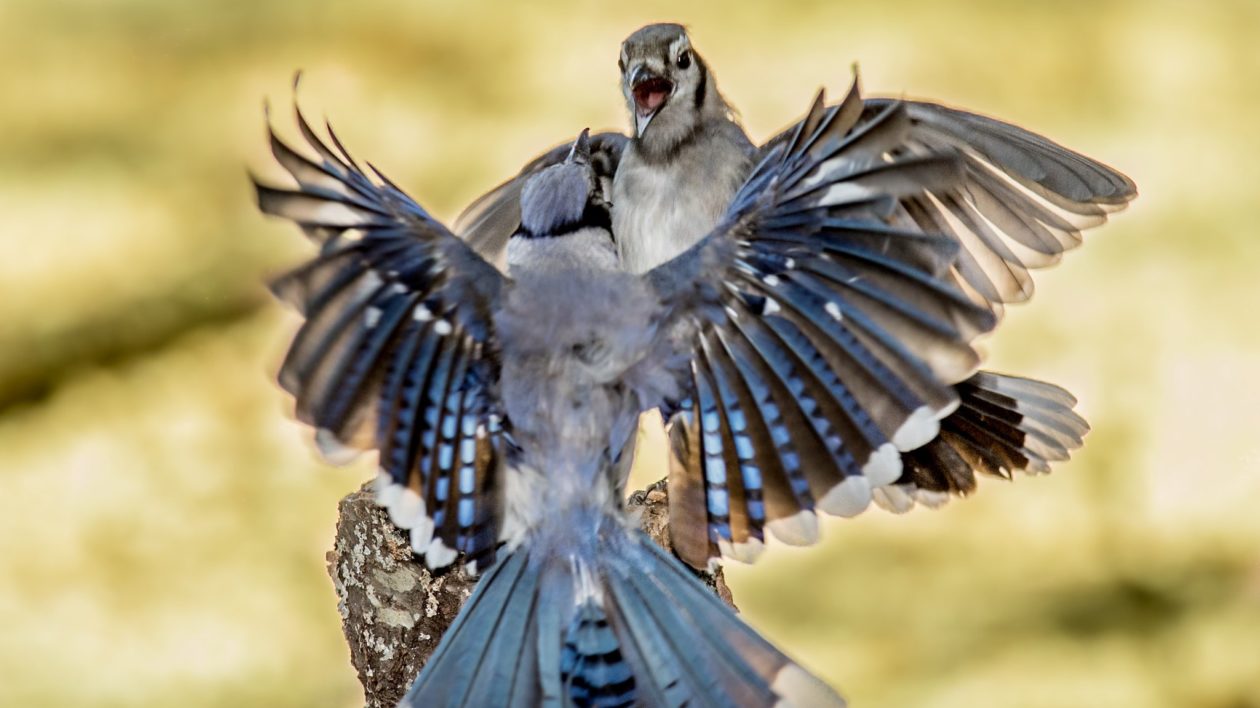
Some oft-repeated claims about blue jays appear to be based on anecdotes that are then applied to the entire species (much in the same way that people blame magpies for all kinds of crimes). For instance, blue jays are well known as nest robbers, gobbling up songbird eggs and hatchlings. And yet, studies conducted since 1897 have found that eggs and birds make up only 1 percent of the blue jay’s diet.
You can find lots of YouTube videos and accounts of blue jays gobbling up eggs, but the reality is they are not major nest raiders. Most of their diet consists of insects, seeds and nuts. They stash lots of acorns and don’t return for many of them, making them significant shapers of the eastern forest. They should be celebrated as a vital part of the woodland rather than derided as being “destructive.”
It turns out that blue jay interactions at the bird feeder are more complex and fascinating, too. The Cornell Lab of Ornithology references a Florida study that found blue jays were not the rulers of the feeders: “Red-bellied Woodpeckers, Red-headed Woodpeckers, Florida Scrub-Jays, Common Grackles, and gray squirrels strongly dominate Blue Jays at feeders, often preventing them from obtaining food.”
The citizen science program Project FeederWatch has obtained extensive data on the interactions of birds at feeders. It’s fascinating stuff. It looked at how “peaceful” or “feisty” birds were, and the results were often surprising.
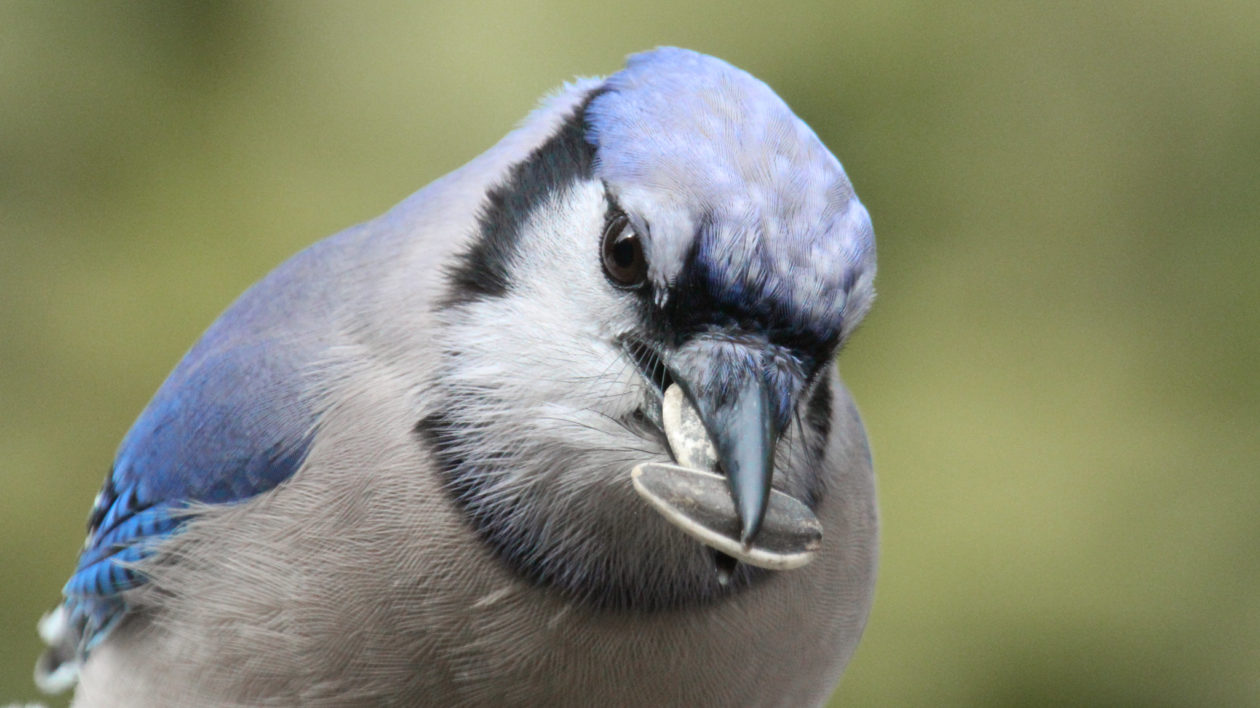
In short, there’s a lot of maneuvering and competing going on at any given feeder. And yes, blue jays can scare off other birds, but they’re hardly alone in this behavior. Research has found that a lot of dominance at feeders is related to size. Simply put, big birds will push away small birds. The most dominant bird? Probably not surprisingly, it’s the wild turkey. No matter how aggressive a blue jay is, it’s not going to scare off a turkey.
Blue jays may be very loud, which earns them their bully reputation. But birds like the beloved chickadees will also harass other birds until they leave. As a side note, if you love observing backyard birds, look at the summary of this study. It found some intriguing results: For instance:
European Starlings are dominant to Red-headed Woodpeckers, Red-headed Woodpeckers are dominant to Red-bellied Woodpeckers, and Red-bellied Woodpeckers are dominant to European Starlings (see diagram at right). This rare non-linear hierarchy may help balance continental patterns of abundance. Each species competes with another for nest cavities, but no species is always the winner.
Your observations at feeders or city parks may reveal similar interactions. Recording what you see can help us better understand bird behavior.
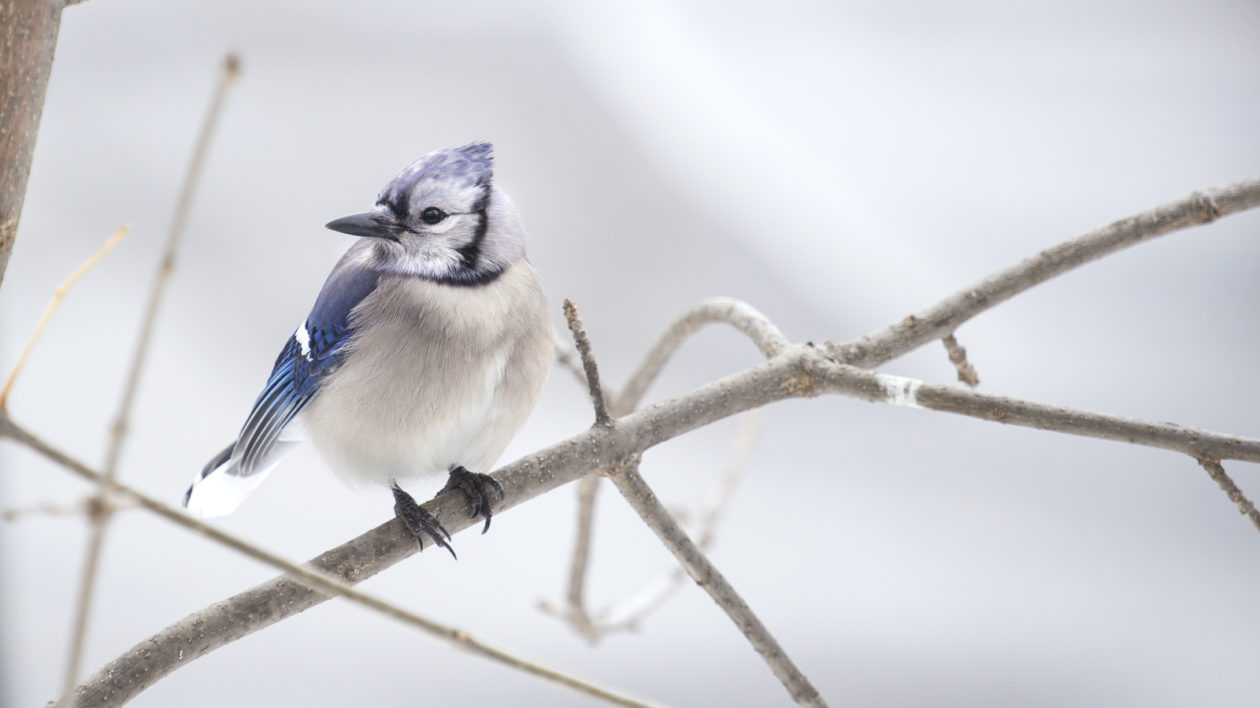
Blue Jay Mysteries
And there is a lot we don’t understand about blue jays. Take their migration, or lack thereof.
Most blue jays don’t migrate. Throughout their range, you will find plentiful blue jays during the winter. But many bird observatories report large flocks of blue jays migrating in the fall, particularly in the Great Lakes and along the Atlantic Coast.
Why blue jays migrate remains a mystery. Cornell estimates that fewer than 20 percent of blue jays migrate annually. And even among the migratory jays, not all make the journey every year. Some researchers believed that migration consisted of young birds dispersing, but others claimed it was old birds. The most recent studies found it’s both.
Blue jays, like many corvids, have complex social lives. They often mate for life and stay with their mate throughout the year. They live in loose flocks in the winter, and have some form of social hierarchy. But again, there is still a lot to learn about this common backyard bird.
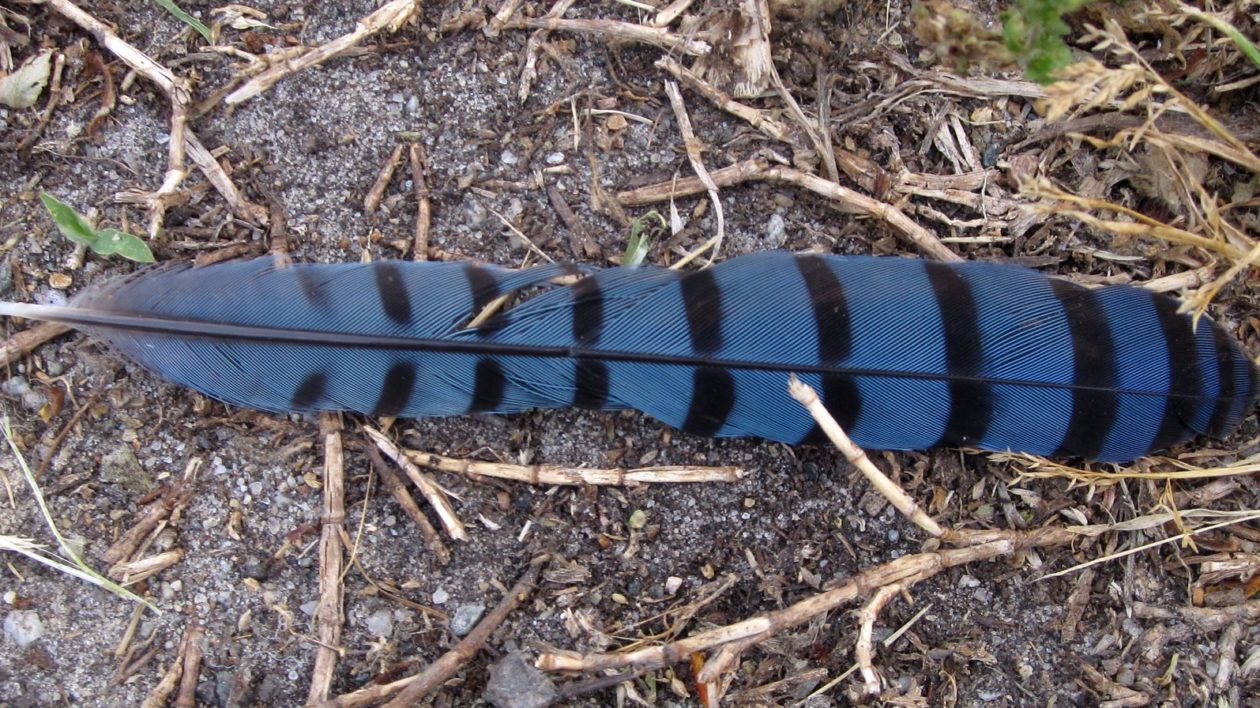
The Spread of Blue Jays
One thing we do know about blue jays: They are thriving and expanding their range. Recent news coverage has reported on the massive declines in North American bird populations over the past few decades. But blue jays are a rare positive story: Their numbers increased 28 percent between 1966 and 2015.
Blue jays have been year-round residents from the eastern United States and Canada to the Great Plains. They are increasingly showing up in the winter in the northwestern United States, where they were rare to non-existent prior to 1972.
While they still cause excitement when spotted at Idaho bird feeders, there are a few reported every year. The same is true for Washington, Utah, Montana and other western states.
Blue jays are adaptable birds, and they thrive in the edge habitats created by suburbia and small woodlands. And yes, they love bird feeders.
Conservationists theorize that, as blue jay populations grow, some jays spread out to new territory. Historically, if they moved to the Northwest, they would have found big wilderness already occupied by Steller’s jays and other species. But now, they find plenty of human habitation, creating ideal blue jay habitat.
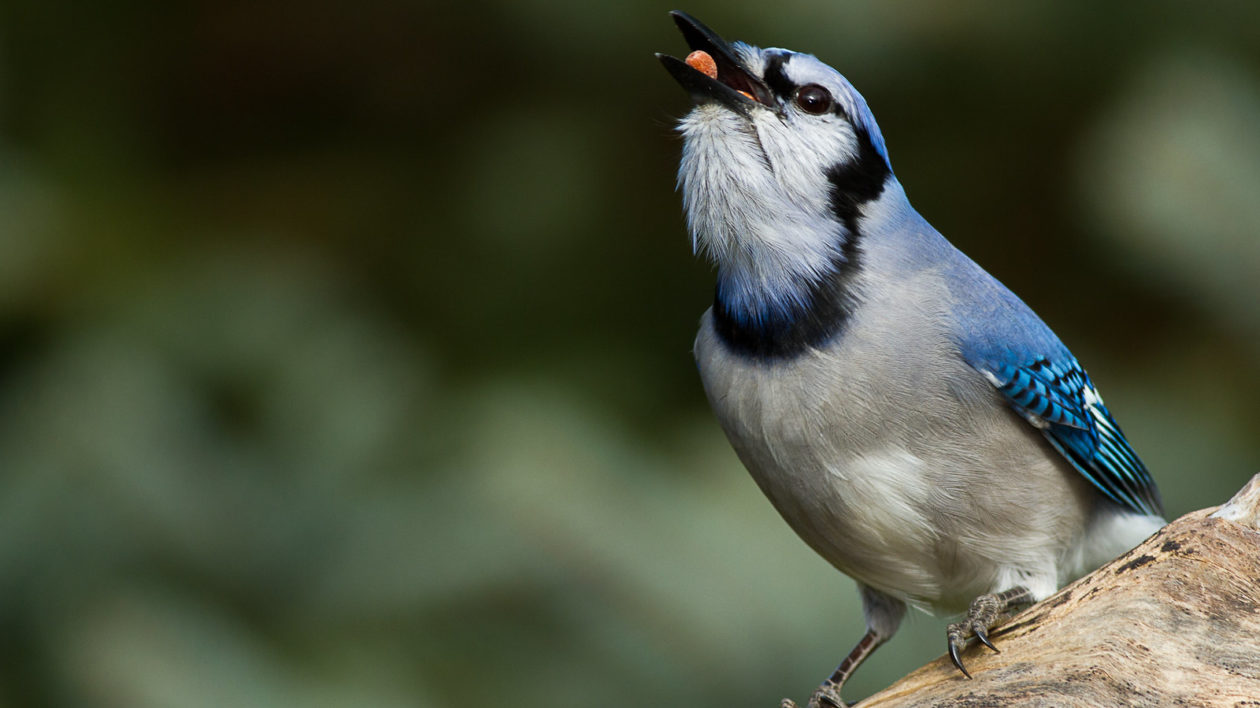
Most of the blue jay sightings in my region are in Idaho cities and towns like Boise, Spokane and Moscow, all places with plenty of parks, edge habitat and feeders.
The excitement caused by a blue jay sighting in the Northwest is understandable. Seen for the first time, the blue jay is a striking bird. But you don’t have to live in Washington to appreciate the jay. As nature photographer Andrew Thompson writes, “If they were not so common, blue jays – with their unique color and markings – would almost certainly be considered among the most beautifully adorned birds.”
So, even if blue jays are the most common and conspicuous birds at your feeder, take another look. Seen with fresh eyes, you might gain a new appreciation for this raucous bird. And your observations of their fascinating behavior can help us better understand what’s happening at our feeders, and assist in bird conservation across the continent.
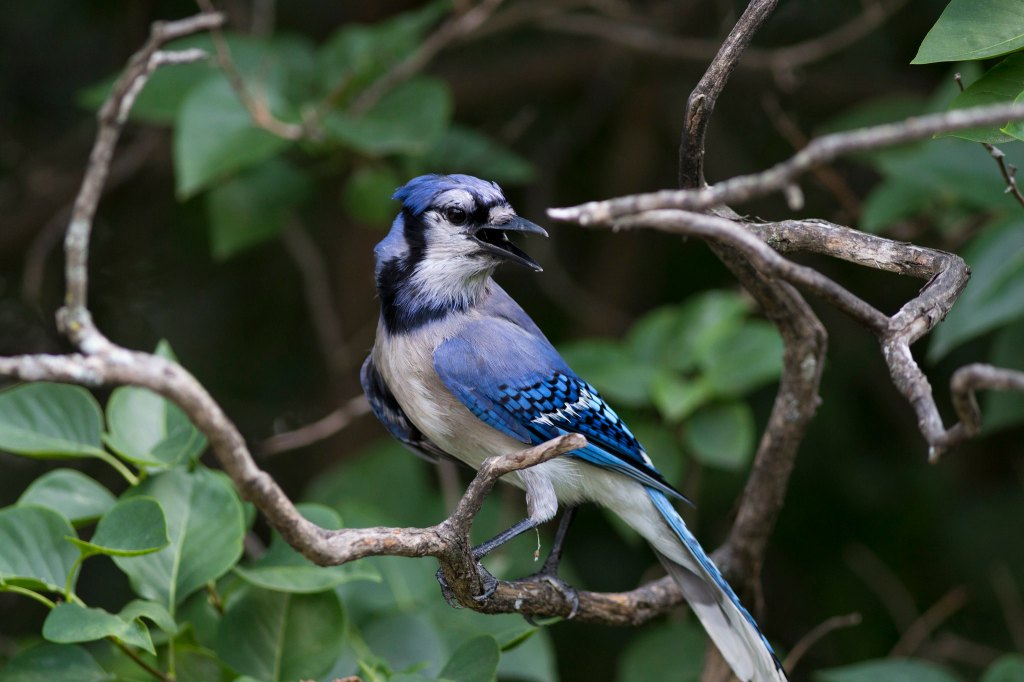



I love blue jays! I grew up in Illinois where they were seen all the time. I now live in Texas in the DFW area and the blue jays have found their way here. I have 3 pair that come to our feeder. One comes in the morning and “ calls me”. I throw out peanuts and soon they are all there.
I’ve noticed to things I never knew about blue jays. First of all, along with their squawk that they are known for, they have a very pretty song they sing. Secondly, as they gather the peanuts, they are able to carry 2and 3 whole peanuts in the shell by maneuvering the peanuts into their mouths under their beaks. Very fascinating.
Thank you for your wonderful article.
Laurie
Roanoke, Tx.
I live in Northern California, A few months ago I found a baby Blue Jay sitting in front of my chicken coop,
it had a damaged wing. I picked it up took in the house cleaned the wing put wound care on (him) every day. I read were I should place him so (he) could hear the other birds outside, which I did. I put him in a cat carrier every morning and placed him out by the chicken coop where he was found, and sure enough two others gathered around him, yes loudly. I would bring him in at night for fear of predators. I would put (him) in the cage with two Parakeet’s, him seemed to be very happy there he would get on the swing and just swing away, loved their food, never bothered them. Back out side every morning. I would hold him by his feet and let him flap his wings, one day I though he was ready, he jumped from branch to branch on a Oak tree, then flew over to another tree about four feet away, I went over to see him and he dropped down right in my arms, back to the cage. Everyday we went though the exercise, two weeks later he flew up and away, he comes every morning and makes his call to me, and every night, yes by the chicken coop. Last week I could hear him, (he) has ventured out a cross the street I guess trying out all the other trees. I did name him (Bert-Birdie) PS while in my care I fed him softened cat food and berries, water with a dropper. Now in a feeder (he) gets along with the others peanuts & sunflower seeds, in a squirrel protected feeder. This was my first introduction to Blue Jays, I love them. Thank you for this opportunity to share my story.
Chicken Linda
I live in Missouri and Blue Jays are commonly seen at feeders. They like black oiled sunflower seeds. They however LOVE peanuts in their shell. I love watching from the window as they swoop down grab a peanut and fly up in the tree. Quickly crack it open , eat it and swoop down for another. I have always been curious about their reputation for being bullies. The blue Jays that come to my feeders are just the opposite. They tend to wait until other birds aren’t close or quickly grab their food and fly off. I love Blue Jays and how beautiful they are. I am always happy to see them come and tend to spoil them as much as I can.
We have a lone Blue Jay at our feeder – has been here since November and has caused quite a stir in the birding community. We are at the south end of Vancouver Island. Now it is mid April and our Blue Jay is still a daily visitor. He stays separate but among the common Stellar Jays. Do you think there is a possibility of a mating?
The urban – wildland difference in Eastern vs. Stellar Blue Jay habitat checks with my north central Washington experience. Eastern Blue Jays have been seen in Wenatchee, but not up here in the Methow, where Stellars are common. I’m wondering if there’s latitude difference as well ? Or maybe it’s just less urban up near Canada ?
I live in the suburbs of central Connecticut i’ve noticed a decline of Blue Jays in this area for sometime this is the first year that I spotted a Bluejay at my feeder I was so Thrilled and excited to see this beautiful bird back again
i find them facinating birds passing by bushes in my complex two followed me with warning crys to stay away as soon as i was out of range they went back. yhey must be very territorial. but cool birds
Greetings! I live in North Texas. I have been an avid gardener for the 23 years that we have lived in our home near corps property surrounding Lake Grapevine. We have a wooded lot that we do not use any pesticide or rodent control on. We are naturalists in a big way. Since my retirement a number of years back, I have had the privilege of spending long hours, even full days, maintaining trees and brush and flowers and foliage. We have copperheads and rat snakes in abundance. I have learned to heed the Blue Jays’ warnings. Often, their squawks have alerted me to a snake coming through the woods and garden or through the thick laurels that have grown into a sanctuary/habitat for the birds. I have observed rat snakes scale the trees and bushes, and even our house. When I discover that a bird’s nest goes empty overnight, I can conjecture that a snake may be a likely suspect. Last summer, I found a sizable, thick copperhead coming through my gardening spot just after the constant squawks and fly thru’s of a Jay. So, for myself, I have experienced the Blue Jay’s squawk as a warning, most certainly.
Thank you for speaking up for Blue Jays! They are one of my favorite birds and not only a joy to see at our feeders every day, but they protect our squirrels and songbirds from our neighborhood hawks. They co-exist quite nicely with our other visitors. The only time they’re noisy (aside from hawk sightings) is when I don’t give them their peanuts in a timely fashion! I’m glad there are other pro-Jay people out there! 🙂
We are near San Francisco and have very aggressive Steller’s Jays. I have feeders designed for the smaller birds, otherwise they would clean me out daily. The Stellers leave when I go to the window, but they try and often succeed at the suet feeder, even if I’m in garden. They will take all the suet they can get away with until I see them. We also have Scrub Jays, which I don’t mind because they take a bite and leave.
LesleytheBirdNerd has a wonderful You Tube channel, check out the Blue Jays on video.
https://www.youtube.com/user/LesleytheBirdNerd/playlists
Saving Jemima: Life and Love with a Hard-Luck Jay by Julie Zickefoose is a good read, too.
Seems to be the winter of the Blue Jay here in northwest Wisconsin. In recent winters a few Jays would visit my feeders, but not every day. This winter Blue Jays show up every day, with 10-12 at a time being common. In the last few weeks several friends have asked me what I’m seeing for this species since they have also observed an abundance of them at their feeders. After a presentation on Wildlife Winter Survival at our local nature center last week I had people ask why all the Blue Jays this winter. I could not give them a definite answer, just a few guesses.
I have observed the local Cardinal and Red-bellied Woodpecker hold off the Blue Jay on the platform feeder if they were there first. There are often half a dozen species at the feeders the same time the Jays are around, so not always that much of a bully. Love watching their behavior when there is a ‘flock’ in the back yard.
I have watched a Blue Jay rescue a Morning Dove from the talons of a Red-Tailed Hawk. The Dove was being squeezed to death by the Hawk with one Blue Jay flew in close and personal attacking the Hawk repeatedly until it finally released its grip and flew away. The Dove survived with the talon maks on its neck the rest of the time I observed it in our area. I was so moved in witnessing the brave Blue Jay saving this Dove I’ve told this story to whomever will listen.
I’ve also witnessed the Blue Jay always sounding the alarm to gather other backyard Jays in our area to chase off Crows and Hawks.
Lastly, one spring morning I stood between 2 trees in which the Blue Jays seemed evenly spaced. The ”cooing” and other delicate and ”sweet” sounds the Jays were exchanging made me wonder if these were courtship calls. They were beautiful and tender, and I stood sometime listening amazed that Blue Jays made such sounds.
I appreciate all their calls and behaviors as a consequence of these and other observations. Blue Jays are our backyard and neighborhood ”watch birds” and I am happy to feed them.
Here in Dallas, Texas, Blue Jays delight us all seasons. Fortunate are we.
Many years ago I heard blue Jays squawking at something. I went to to find my dog, a Gordon Setter, flat on his belly on the deck, with 3 Jays swooping down on him and screeching at him.he was totally intimidated!
This was a dog that ran into the river to go after a swan, so he wasn’t a wimp! I had to scare off the Jays before he would get up- he ran for the door!
We watched a blue jay mimic a merlin’s call. The call cleared out the bird bath so the jay could take a leisurely bath. When finished, flew to a nearby shrub, gave a few more “merlin” calls allowing for uninterrupted feather preening. The jay employed the “merlin” call frequently last summer and fall.
Blue jays are a constant sight and sound in my yard early morning and mid afternoon when I give squirrels nuts and feed birds. They are so loud until my resident red headed woodpecker comes down the tree to grab a nut or two usually followed by the jays taking off however they return shortly after noisy as ever. But I admit they are a beautiful bird.